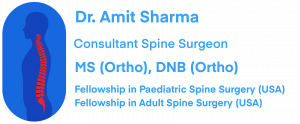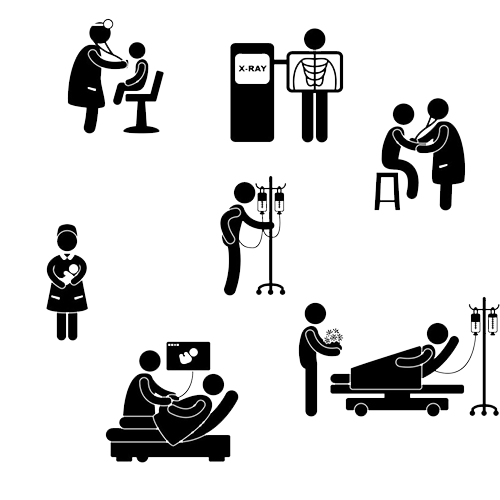Best Spine Surgeon in Mumbai | Dr. Amit Sharma

+91-9967600461
draks777@gmail.com
Post-operative care after spine surgery!!

Post-operative care after spine surgery!!
Precautions and Care after Spine Surgery
Having a spine surgery is big decision for patients. Patients are worried not only about the surgery, but also about the recovery after the spine surgery. Here, we summarize the routine post-operative care of a patient after the spine surgery.
Wound-care and bath:
It is a common practice to change dressing repeatedly, even if it is clean. Patients also ask doctor how frequently dressing changes are required. A dressing change is usually not required at all after minimally invasive spine surgeries, unless dressing material is soaked with blood/ liquid/ body fluids (sweat, urine or stool). For a bigger/ open surgery, a dressing change is usually done before discharge from hospital.
A drain is inserted for a bigger surgery or for surgeries where excessive bleeding occurs. Drain helps remove excess blood from surgical wound. This excess blood would otherwise collect inside the wound and can become a source of infection, or can seep through wound leading to delay in wound healing. In these cases, dressing change after surgery is done simultaneously with drain removal.
At home, patients don’t have to change dressing unless it is soaked or comes off the skin. Usually, it is directly removed at the time of suture/ staples removal after two weeks. A temporary dressing might be applied after suture removal for couple of days to let suture removal holes heal. Many patients have absorbable stitches. These patients do not require any stitch removal. Small steri-strip dressings might be left around the wound, which fall-off automatically while taking bath in few days.
Patient are allowed to take light shower 4-5 days after the surgery. It is advisable to avoid letting water-soap go in the wound to avoid infection. Wiping the body clean with a wet towel is another option. Water repellent dressings which stick to skin helps keep the wound dry.
Infections, though rare, can happen. A warm, red and swollen wound indicates infection, especially if there is frequent, foul smelling discharge associated with fever and chills. In this situation, your surgeon need to be informed immediately.
Mobilization:
Patients are allowed to sit and walk same/ next day after the spine surgery in majority of the cases. Usually there are no restriction in terms of how long a patient can sit on chair, stand or walk. Patients are allowed to do these activities as per their comfort level. This is true even for open surgeries. Robust titanium implants allow immediate weight bearing after spinal instrumentation surgeries.
Patient who have pre-operative weakness in legs might have to wait until leg power returns before they can walk. However, even in these cases sitting is allowed immediately. Implant hold is not strong enough in severely osteoporotic bones. These patients might have to take prolonged bed rest until spinal fusion takes place to prevent implant loosening/ breakage.
Household work:
Patients are allowed to do any household work in sitting/ standing position as soon as they are comfortable. There is usually no restriction in terms of duration for which they can sit, stand or walk. However, bending forward, sitting on floor and heavy lifting need to be avoided.
Other activities:
Patients are allowed to do all activities in chair-sitting and standing position as per their comfort. Activities involving walking are also allowed, e.g. going to local market, walking in park etc. Patient can do stair-climbing as well.
It is advised to avoid following activities:
- Sitting on floor,
- Bending forward,
- Lifting heavy weight (more than 5 kg).
- Twisting the body.
These restrictions are usually applied for 4-6 weeks to let disc and soft tissue at surgical site heal. Also, spinal fusion surgeries require about 3-6 months for bone healing and consolidation. Heavy labor, lifting very heavy weight and sports activities are better avoided for 6 months after fusion surgeries. These restrictions are applied to prevent recurrence of symptoms after spine decompression surgery and to prevent implant failure (loosening/ breakage) after spine fusion surgery.
Return to work:
Patients involved in desk job/ office work can join their work as soon as they are comfortable. People involved in long travelling and mild-moderate laborious activities should wait 3-4 weeks before joining work after a decompression surgery and about 6-8 weeks after a spine fusion surgery. Heavy manual labor is better avoided for 3-6 months.
Use of brace:
A cervical or lumbar belt is usually given after surgery to provide support to the spine. These braces provide some support to the spine; however, there primary function is to limit spine movements, give comfort to the patient and keep reminding them about the surgery so they continue taking routine precautions. A 4-6 weeks period is recommended usually for brace-wearing. After that, patients are asked to gradually wean it off. It is recommended to apply brace while travelling for a longer period to avoid sudden jerk to post-operative spine.
Physiotherapy:
Patient require slight help to sit and walk immediately after surgery. Physiotherapy is provided when they are in hospital. Once discharged, most of the patients don’t need regular physiotherapy. They are encouraged to perform activities on their own. However, patients with pre-operative weakness, excessive weight and other medical problems might need a longer course of physiotherapy. This can be arranged at home also. For patients with weakness in legs/ arms, electrical muscle stimulation therapy is required for few weeks to help muscles recover.
Pain during recovery:
Pain after spine surgery is tolerable. During hospital stay heavy pain medications are given by mouth and IV route. After discharge, patients are given gradually reducing doses of pain medicines expecting pain to go down gradually as healing takes place. Some pain medications are prescribed after suture removal also to be taken on as and when required (sos) basis.
Nerve recovery:
Nerve compression can cause multiple symptoms. Pain, tingling-numbness, loss of sensation and muscle weakness occur usually in sequence. With severe spinal cord compression, bowel and bladder are also affected. Even though spinal cord and nerves are free after surgery, recovery doesn’t happen immediately. Pain symptoms (radiculopathy) are usually first to improve. Tingling-numbness can persist for long time. Weakness in muscles and bowel-bladder involvement take a very long time to recover as these symptoms indicate significant damage to nerve functions.
Also, nerve recovery is never linear. Patients usually perceive recurrent bouts of pain and numbness while recovering. They should be informed about this phenomenon to avoid anxiety.
Sleeping after spine surgery:
Patients need to follow same principles for sleep after spine surgery as recommended for someone suffering from neck pain/ back pain. Sleeping on firm mattress is better to support spinal alignment. A thin pillow/ cervical pillow should be used after cervical spine surgeries. Keeping a pillow under knees will relax spinal muscles and reduce symptoms of nerve pull. When turning in bed, shoulder and hips should turn together (log-rolling) to avoid twisting force to spine.
While getting up from lying down position, it is recommended first to turn to one side and then get up on your side. This maneuver prevent excessive strain on back while getting up. Similarly for lying down, it is recommended to sit at the edge of the bed first, then lie down in lateral position and finally turn straight on your back.
Sleeping on floor should be avoided for at least 4-6 weeks (more for fusion surgery) as getting up and lying down involves lot of twisting and bending movements, which puts stress on healing spine.
Travelling:
It is better to avoid long travels. Bike rides should be absolutely avoided for initial 4-6 weeks. In car, patient should either sit on a fully reclined passenger seat next to the driver or lie down in back seat. It is recommended to use brace while travelling for 3 months after the surgery. Patient can start driving within 2-3 weeks after the surgery. A pillow/ lumbar arch support should be used while driving. Also, car seat height should be increased to keep knees at same level/ below the level of hips. Other routine driving precautions should be taken.
For air travel, ensure you don’t have to lift heavy weight. Lifting baggage from conveyor belt is one of the worst thing we do to our back as this activity involves bending forward and lifting simultaneously and baggage is usually heavy during air travel. It’s better to walk after every hour or so in the aisle to avoid DVT.
Toilet activities:
Use of Indian style lavatories, in which squatting is required, should be avoided as it puts lot of pressure on spine. Readymade chair commodes are available on rental for use in post-operative period. Even for western lavatories, a seat raise can be used for comfort. Use of a hand rail or a handle to assist in getting up from sitting position can be very helpful. Use of laxative is advised to keep stool soft as excessive straining to pass stool may put pressure on wound.
Post-operative X-ray/ MRI:
Repeat x-ray/ MRI is usually not required after a spine decompression surgery. However, if patient has persistent/ recurrent symptoms, an MRI can be done. X-rays are usually done at repeated intervals after a spine fusion surgery to assess implant position and bone healing.
Contact your surgeon immediately if any of the following occurs:
- Excessive, frequent bleeding through wound,
- Signs of infection (see above),
- Severe pain not controlled by medications,
- Fall during walking,
- New symptom related to nerve pressure (pain in arm/ leg, numbness, weakness, difficulty in passing urine),
- Any other new symptom.
Thank you for sharing an important information.
Thank you
Thank you.
I want to express my appreciation for this incredibly informative and comprehensive guide on post-operative care after spine surgery. The blog post covers a wide range of important topics related to post-operative care, addressing not only physical aspects but also emotional and psychological considerations. The article provides practical tips and suggestions on pain management, wound care, medication, and rehabilitation exercises. I found this blog post to be a valuable resource for anyone preparing for or recovering from spine surgery. Thanks for sharing!
Thank you very much for your appreciation.
Thank you for your appreciation
Thanks a lot for usefull information.. my father had surgery of spine.. removed tumour from spine compressing nerve of legs.. 18 days passed but still my father unable to stand yet.. how much time will it take to stand or walk..?
It can take up to two years for recovery.
Dr. Sharma, your comprehensive guide on post-operative care following spine surgery is invaluable for patients who have undergone or are considering spine surgery. The meticulous detail you provided from wound care to mobilization and even to activities like travelling underscores the importance of a holistic approach to post-operative care. It resonates with the emphasis we place on patient education and empowerment in our recent article titled “Comparing Chiropractic and Physiotherapy Protocols with a Focus on Patient Education for Empowered Rehabilitation“. Our piece delves into the differences and synergies between chiropractic and physiotherapy, emphasizing the role of informed patients in their own recovery journey. The parallels in our perspectives highlight the importance of thorough guidance and continuous learning in the realm of spine health and overall wellbeing.